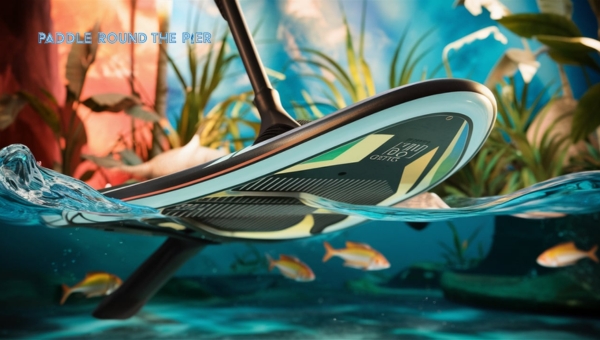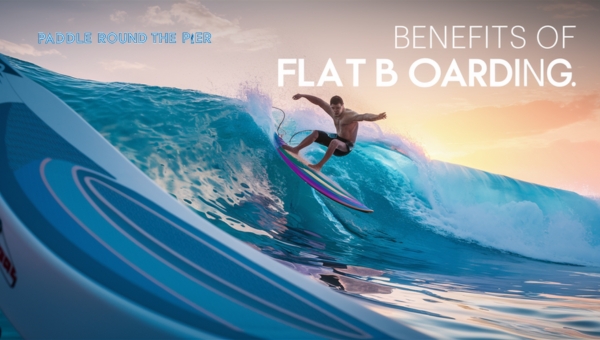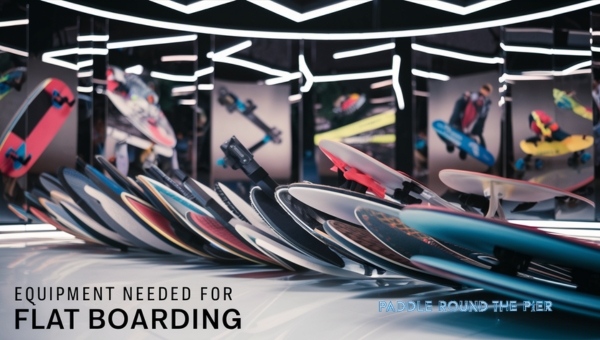Flat Boarding: Your Definitive Guide to Mastering the Waves
Welcome to your ultimate guide on flat boarding! If you're eager to explore an exciting way to boost your fitness and mental well-being, look no further. Flat boarding, a thrilling blend of balance, strength, and endurance, offers countless benefits.
In this article, we'll delve into the essentials of flat boarding, explore its numerous advantages, discuss the equipment you need, and provide tips to get started. By the end, you'll be equipped with everything you need to embark on your flat boarding journey. Ready to dive in? Let's get started!
What precisely is flatboarding?
Flat boarding, also known as stand-up paddleboarding (SUP), involves standing on a board and using a paddle to move across calm water surfaces such as lakes and rivers. This activity combines balance, strength, and endurance, making it a popular choice for both recreation and fitness. Imagine gliding smoothly over the water, feeling the gentle breeze and rhythmic motion.

Flat boarding is accessible to people of all ages and skill levels. It offers a full-body workout, engaging your core, arms, shoulders, and legs. Not only does it help improve physical fitness, but it also provides a calming and meditative experience, enhancing mental well-being.
Benefits of Flat Boarding
Flat boarding is more than just a fun activity on the water. It offers numerous benefits that can enhance both your physical fitness and mental wellbeing. Let’s dive into how this exciting sport can positively impact your life in various ways.

Physical Fitness
Engaging in flat boarding can do wonders for your physical fitness. This activity provides a full-body workout, working your core, arms, shoulders, and legs.
It’s an excellent way to improve your cardiovascular health because it gets your heart pumping and increases your stamina.
Additionally, the balance required for flat boarding helps enhance your overall stability and muscle strength. Whether you're paddling through calm waters or tackling gentle waves, your body is constantly in motion, burning calories and building muscle.
Mental Wellbeing
Flat boarding also offers significant mental health benefits. Being out on the water can be incredibly soothing, providing a peaceful escape from daily stress.
Here are some of the mental benefits you can gain from flat boarding:
- Stress Reduction: The rhythmic motion of paddling and the calming environment of water can help lower stress levels.
- Improved Mood: Engaging in this outdoor activity releases endorphins, which are natural mood lifters.
- Enhanced Focus: Flat boarding requires concentration and mindfulness, contributing to better mental clarity and focus.
By incorporating flat boarding into your routine, you can enjoy a healthier body and a happier mind.
Also Read: Kayak Scupper Plugs: Essential Tips and Effective Techniques
Equipment Needed for Flat Boarding
Before you dive into flat boarding, it's essential to have the right equipment. This will not only enhance your experience but also ensure your safety. Let's explore the types of boards you can choose from and the necessary safety gear you'll need.

Types of Boards
When it comes to flat boarding, selecting the right board is crucial. There are mainly two types of boards to consider:
- Inflatable Boards: These boards are portable and great for beginners. They are easy to store and transport, making them a popular choice for those new to the sport.
- Rigid Boards: These offer better performance and are ideal for those looking to take their flat boarding skills to the next level. They provide more stability and speed but require more storage space.
Choosing the right board depends on your skill level, weight capacity, and intended use. Beginners might find inflatable boards more forgiving, while advanced users often prefer the performance of rigid boards.
Safety Gear
Staying safe while flat boarding is paramount. Here’s a list of essential safety gear you should have:
- Personal Flotation Device (PFD): A must-have for safety, ensuring you stay afloat if you fall into the water.
- Helmet: Protects your head from potential impacts, especially in rocky or crowded areas.
- Pads (Knee and Elbow): These protect your joints from injuries during falls or unexpected bumps.
- Leash: Keeps you connected to your board, preventing it from drifting away if you fall off.
Equipping yourself with the right safety gear will provide peace of mind and a secure flat boarding experience.
How to Get Started with Flat Boarding
Embarking on your flat boarding journey can be an exciting experience. Whether you're a complete beginner or looking to refine your skills, understanding the basics is crucial. Let's dive into some essential techniques and tips for finding the perfect locations to practice.
Basic Techniques
Mastering the fundamentals can make a huge difference in your flat boarding adventure. Here are the key techniques to get you started:
- Stance: Stand with your feet shoulder-width apart and keep your knees slightly bent to maintain balance.
- Paddling: Use smooth, alternating strokes with a vertical paddle to move efficiently through the water.
- Balance: Ensure your weight is centered over the board, distributing it evenly to stay stable.
Finding Suitable Locations
Choosing the right spot to practice is important for your progress and safety. Here are some tips for finding beginner-friendly locations:
- Calm Waters: Look for areas like lakes or slow-moving rivers where the water is calm and predictable.
- Local Parks: Many parks offer flat boarding rentals and designated areas for beginners.
- Water Sports Shops: These shops often have information on the best local spots for flat boarding, suitable for various skill levels.
By focusing on these basics and picking the right locations, you'll be well on your way to enjoying flat boarding to the fullest!
Also Read: Kayak Scupper Plugs: Essential Tips and Effective Techniques
Tips for Improving Your Flat Boarding Skills
If you're eager to take your flatboarding skills to the next level, you're in the right place. Enhancing your abilities involves focusing on balance and learning advanced maneuvers. Ready to dive in? Let's get started!
Enhancing Balance
Improving your balance is crucial for flat boarding. Here are some effective ways to get better:
- Practice Yoga: Yoga helps strengthen your core and improves overall stability. Poses like the tree pose or warrior pose can be particularly beneficial.
- Use a Balance Board: Training on a balance board mimics the movement you'll experience on the water, making it a fantastic practice tool.
- Core Exercises: Incorporate exercises like planks, sit-ups, and leg raises into your workout routine. A strong core is key to staying upright on your board.
Advanced Maneuvers
Once you're comfortable with the basics, it's time to explore some advanced techniques:
- Pivot Turns: This maneuver involves stepping back on your board to lift the nose and then rotating the board around. It's great for quick direction changes.
- Cross-Bow Strokes: This technique allows you to paddle on the opposite side of the board without switching sides, providing more control and efficiency.
- Surf Stance: Transitioning to a surf stance can help you ride waves or handle rougher waters. Practice shifting your weight and stance to adapt to different conditions.
By focusing on balance and mastering these advanced maneuvers, you'll become a more skilled and confident flatboarder. Happy paddling!
Common Mistakes to Avoid
When starting with flat boarding, it's easy to make some common mistakes. Let's dive into these pitfalls and how to steer clear of them:
1. Poor Stance:
- Mistake: Beginners often stand too rigidly or place their feet too close together.
- Solution: Keep your feet shoulder-width apart and your knees slightly bent. This will help you maintain balance and control.
2. Incorrect Paddling:
- Mistake: Relying too much on upper body strength instead of engaging the core.
- Solution: Use your core muscles for paddling. This not only makes paddling more efficient but also enhances your overall stability.
3. Neglecting Safety Gear:
- Mistake: Not wearing essential safety gear like a personal flotation device (PFD) or helmet.
- Solution: Always wear a PFD and consider using a helmet, especially in areas with more challenging water conditions. Safety gear can prevent injuries and ensure a safer experience.
4. Overlooking Weather Conditions:
- Mistake: Ignoring weather forecasts or not being prepared for sudden changes.
- Solution: Check the weather forecast before you head out. Be prepared for changes and avoid flat boarding in stormy or windy conditions.
5. Failing to Warm Up:
- Mistake: Skipping warm-up exercises before starting.
- Solution: Perform a quick warm-up to loosen your muscles. This can include stretches and light exercises to prepare your body for the activity.
6. Holding the Paddle Incorrectly:
- Mistake: Gripping the paddle too tightly or holding it at the wrong angle.
- Solution: Hold the paddle with a relaxed grip and position it at a vertical angle when paddling. This technique improves efficiency and reduces strain on your arms.
7. Not Looking Ahead:
- Mistake: Focusing too much on the board or water right in front of you.
- Solution: Look ahead to where you want to go. This helps in maintaining balance and navigating more efficiently.
8. Inadequate Hydration:
- Mistake: Forgetting to stay hydrated while out on the water.
- Solution: Bring a water bottle and take regular sips. Staying hydrated is crucial, especially when spending extended periods on the water.
9. Ignoring Proper Technique:
- Mistake: Not paying attention to proper paddling and stance techniques.
- Solution: Take the time to learn and practice the correct techniques. This will improve your performance and make flatboarding more enjoyable.
Avoiding these common mistakes can lead to a safer, more enjoyable flatboarding experience. Happy paddling!
FAQs
Why is paddle boarding so popular?
Paddle boarding is popular because it's accessible for all ages and fitness levels. It offers a full-body workout while allowing you to enjoy the serenity of being on the water. Plus, it's a fun way to explore nature and get some fresh air.
What is the point of paddleboarding?
The main point of paddleboarding is to blend physical exercise with relaxation. It helps improve balance and strength while providing a peaceful experience in calm waters, making it both a recreational and fitness activity.
Do you wear shoes when paddle boarding?
It's generally optional to wear shoes while paddle boarding. Some prefer going barefoot for better grip and balance, while others opt for water shoes to protect their feet from rough surfaces.
Conclusion
Flat boarding is an exciting and beneficial activity that offers both physical and mental health advantages. From improving cardiovascular health to reducing stress, this sport caters to all fitness levels.
By understanding the necessary equipment, mastering basic techniques, and avoiding common mistakes, you can fully enjoy the experience. Whether you are a beginner or looking to advance your skills, there's always room to grow in the world of flatboarding.
Ready to dive deeper into other interesting topics? Explore more on our blog and keep discovering new ways to stay active and healthy!